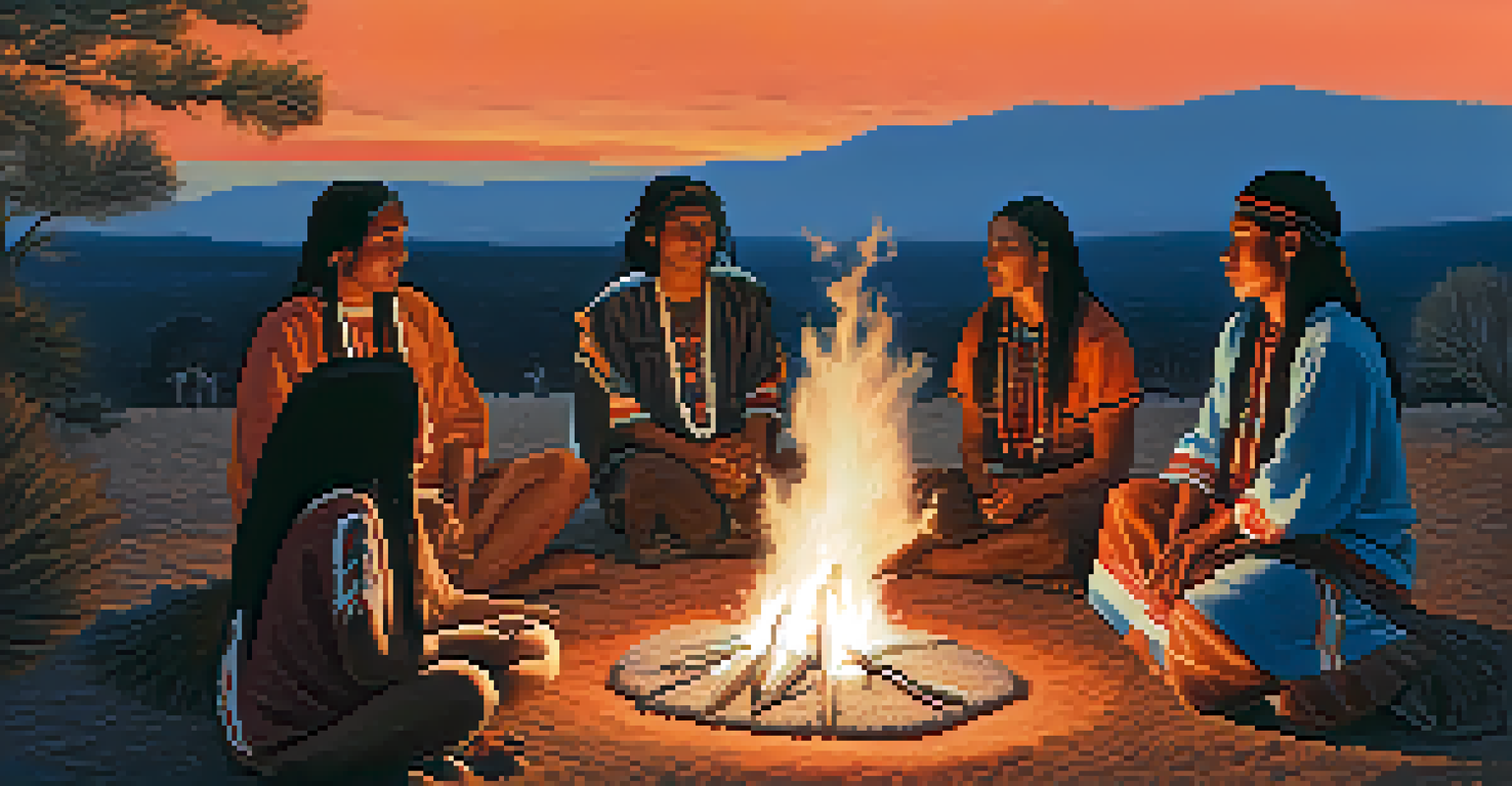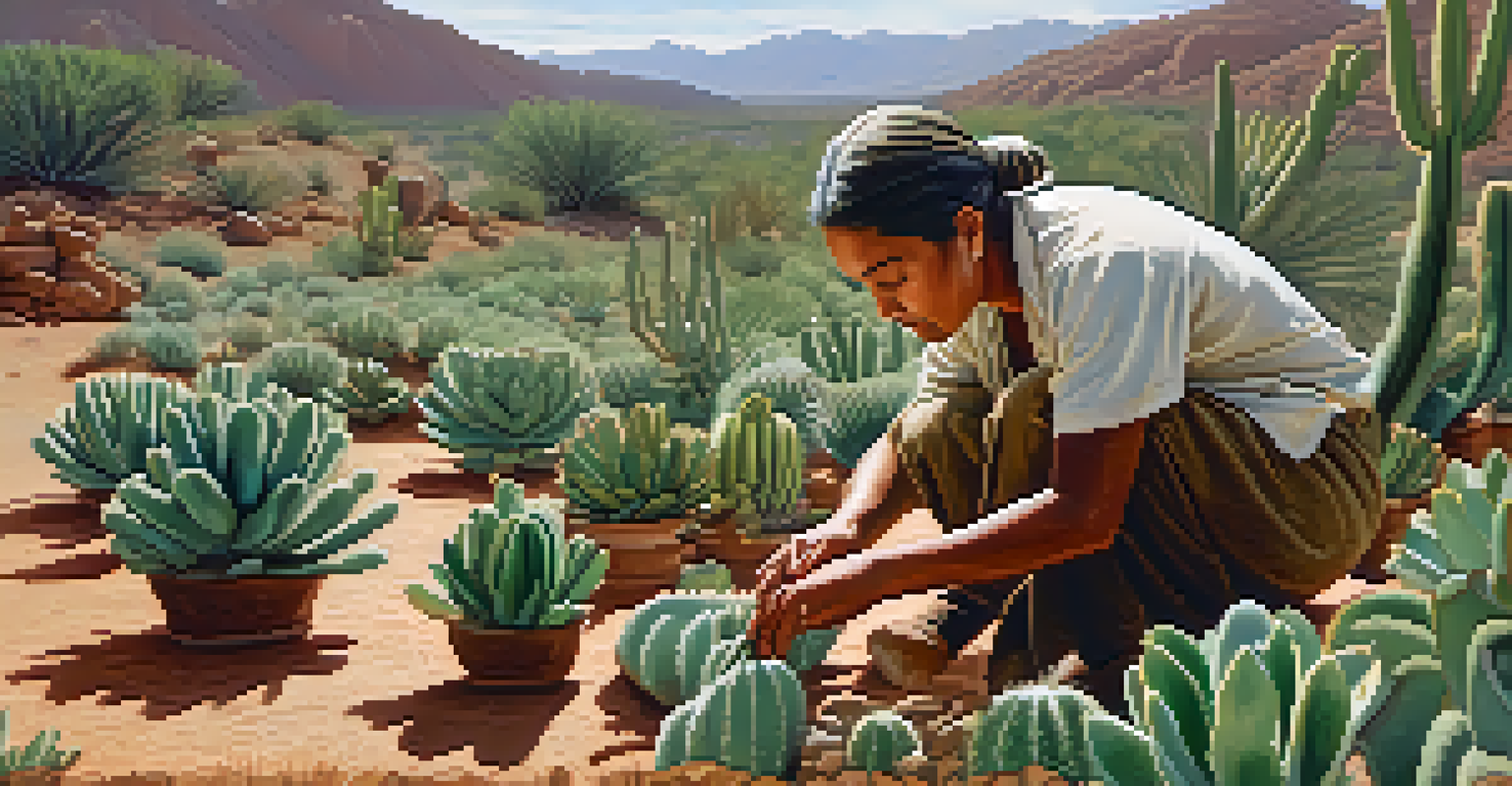Historical Perspectives on Peyote Use in Native American Cultures

Understanding Peyote: A Sacred Plant
Peyote, a small cactus native to Mexico and the southern United States, has been used for thousands of years by Native American cultures. Known for its psychoactive properties, peyote contains mescaline, a compound that induces altered states of consciousness. These experiences are often viewed as spiritual awakenings, allowing users to connect deeply with their heritage and the spirit world.
The use of peyote is a profound spiritual journey that connects individuals to their ancestors and the natural world.
In various tribes, peyote is not just a plant; it is a sacred entity that plays a pivotal role in religious ceremonies. For many, the act of consuming peyote is a rite of passage, a way to seek guidance from ancestors or divine beings. This spiritual significance sets peyote apart from other substances, emphasizing its importance in cultural practices.
While peyote is celebrated for its spiritual benefits, it is essential to approach its use with respect and understanding. Many tribes have their own traditions surrounding peyote consumption, which are rooted in centuries of history and belief. This deep connection to the land and their ancestors highlights why peyote is revered within Native American cultures.
Historical Context of Peyote Use
The use of peyote dates back to pre-Columbian times, with archaeological evidence suggesting its consumption as early as 5,700 years ago. Early Native American tribes, including the Huichol and the Tarahumara, incorporated peyote into their spiritual practices, using it to facilitate communication with the divine. This long-standing tradition emphasizes the deep roots of peyote use in the fabric of Native American life.

As European settlers arrived, they often misunderstood or dismissed indigenous practices, including those involving peyote. Many tribes faced suppression of their cultural rituals, and the use of peyote was sometimes criminalized. Despite these challenges, peyote use persisted, serving as a form of resistance and cultural preservation for many Native communities.
Peyote's Sacred Role in Culture
Peyote is revered as a sacred plant in Native American cultures, integral to spiritual ceremonies and communal gatherings.
The 20th century marked a renewed interest in peyote, particularly with the establishment of the Native American Church in the 1910s. This organization sought to unite various tribes in their peyote practices, advocating for its use as a legitimate religious sacrament. This movement has played a crucial role in protecting the rights of Native Americans to practice their traditions freely.
Peyote in Religious Practices
In many Native American religions, peyote is central to spiritual ceremonies, often used in healing rituals and communal gatherings. These ceremonies are designed to foster a sense of unity among participants, allowing them to share experiences and connect on a deeper level. The communal aspect of peyote use highlights its role in strengthening tribal bonds and cultural identity.
Peyote serves as a bridge to our ancestors' wisdom and experiences, fostering a sense of belonging among Native American communities.
During a peyote ceremony, participants often engage in singing, drumming, and prayer, creating a rich tapestry of spiritual expression. The experience is not just about the individual; it emphasizes collective healing and understanding. As participants share their visions and insights, they contribute to a larger narrative that reaffirms their cultural values.
The integration of peyote into religious practices also serves as a form of resistance against cultural erasure. By maintaining these traditions, Native American communities assert their identity and heritage in the face of historical oppression. This resilience is a testament to the enduring power of peyote in their spiritual lives.
Cultural Significance of Peyote
Beyond its religious applications, peyote holds immense cultural significance for many Native American tribes. It is often viewed as a symbol of survival, resilience, and spiritual connection to the earth. The act of gathering and preparing peyote is steeped in tradition, involving rituals that honor the plant and its place in their lives.
For many tribes, peyote is more than just a sacrament; it embodies a way of life that prioritizes harmony with nature and respect for all living beings. This perspective fosters a sense of stewardship for the environment, as the land is viewed as sacred. The cultivation and preservation of peyote further reinforce these values, creating a symbiotic relationship between the plant and the people.
Historical Resilience of Peyote Use
Despite challenges and legal restrictions, peyote use has persisted as a form of cultural preservation and resistance among Native tribes.
This cultural significance extends beyond individual tribes, influencing broader discussions about indigenous rights and environmental conservation. As more people recognize the importance of traditional ecological knowledge, the role of peyote in Native American cultures has become a focal point for advocacy and education.
Legal Challenges and Advocacy
The legal status of peyote has been contentious, particularly as debates over drug use and indigenous rights have emerged. While peyote is classified as a controlled substance under federal law, exceptions exist for its use in religious ceremonies among recognized Native American tribes. This legal framework aims to balance the protection of cultural practices with concerns surrounding substance use.
However, the complexities of legal challenges continue to affect many tribes. Some have faced difficulties in establishing their rights to use peyote, often due to misunderstandings about its significance. Advocacy efforts have been crucial in raising awareness about the importance of peyote in indigenous cultures, pushing for policies that honor their rights to practice their traditions.
Recent court rulings and legislative initiatives have sought to protect the religious use of peyote, recognizing it as a fundamental aspect of Native American identity. These developments represent a significant step toward reconciling historical injustices and affirming the rights of indigenous peoples to their cultural practices.
Peyote's Role in Modern Native American Identity
In contemporary society, peyote continues to play a vital role in shaping Native American identity. For many, participating in peyote ceremonies is a means of reconnecting with their heritage and fostering a sense of belonging. This revival of traditional practices reflects a broader movement among indigenous communities to reclaim their cultural narratives.
As younger generations seek to understand their roots, peyote serves as a bridge to their ancestors' wisdom and experiences. The act of engaging with peyote is often accompanied by a commitment to preserving and promoting cultural knowledge. This intergenerational exchange strengthens community bonds and ensures that these traditions are passed down.
Future Challenges for Peyote
The future of peyote use will depend on ongoing advocacy, legal recognition, and environmental preservation efforts to protect this sacred plant.
Moreover, the visibility of peyote in popular culture has sparked interest and dialogue about Native American issues. While this can sometimes lead to misconceptions, it also opens avenues for education and understanding, allowing broader audiences to appreciate the significance of peyote in native cultures.
Future Perspectives on Peyote Usage
Looking ahead, the future of peyote use among Native American cultures will likely be shaped by ongoing legal and societal changes. As more states consider the legalization of various substances, discussions about peyote's status may evolve. It will be crucial for indigenous voices to be at the forefront of these conversations to ensure that their rights and traditions are respected.
Additionally, as environmental concerns grow, the cultivation of peyote may face challenges due to habitat loss and climate change. Protecting natural habitats and promoting sustainable practices will be essential to preserve this sacred plant for future generations. Collaborative efforts between tribes and environmental organizations could pave the way for a more sustainable future.

Ultimately, peyote remains a powerful symbol of identity, resilience, and spiritual connection within Native American cultures. As these communities continue to navigate the complexities of modern life, the enduring legacy of peyote will undoubtedly shape their cultural landscape for years to come.